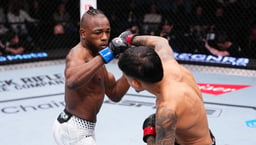
Issue 029
September 2007
Written by Jim Burman and Hywel Teague
Picture this: You’re sat on the sofa watching the latest UFC or Cage Rage on TV. Your female companion comes in and sits next to you, twists her face into that disapproving scowl you hate her mother for so much, and begins with the questions.
“So who’s that guy?” she says.
“That’s Randy Couture,” you reply.
“Who is he?”
“He’s the man.”
“Why is he the man?”
“Because he’s a three-time heavyweight champion, has held titles in different weight categories, was a pioneer in the early days of MMA and is an excellent ambassador for the sport! That’s why!” By now, you’ve made it clear you want to get back to watching the fight, and she goes back to filing her nails and reading a magazine that claims to have the latest celebrity diets. Five minutes later, and she asks; “So, who’s that guy?”
Of course, the opposite can be just as common. Shows like The Ultimate Fighter have done much to bring in the ladies, and a whole legion of new fans are still out there ready and waiting with a tonne more questions.
This is where our handy Girlfriend’s Guide will come into play. No longer will you be left struggling for answers to those tricky questions posed by the lady in your life, whether girlfriend, wife, mother, sister or simply some random person walking by your window and wondering what all the noise was about as you were shouting at the TV!
Have the Guide handy for quick reference, or simply leave it lying around somewhere she’ll find it (in the fridge, under her pillow, maybe even slipped inside her copy of Cosmo…) and look forward to a future free of questions, enabling you to enjoy your MMA in peace.
Frequently Asked Questions
Why is it in a cage?
For safety! Putting them in a boxing ring means there is a risk of them falling out between the ropes, and this has happened plenty of times in events that don’t use a cage.
Is it like that wrestling that Hulk Hogan used to be in?
No. No, no and no. The difference is that this is real, or to coin one of the UFC’s phrases, ‘As real as it gets!’
Do they fight to the death?
Ha ha ha, noooooo. You’ve been watching too many Jean Claude Van Damme movies!
Can you use weapons?
This isn’t fake wrestling, no steel chairs allowed.
Why are they rolling around on the floor?
MMA allows a fighter to wrestle his opponent and look for submissions as well as stand and trade strikes. He can end a fight by forcing his opponent to tap out to a choke or joint lock. Sometimes it may look like they’re doing nothing but the ground game isn’t easy to understand straight away – but keep watching and suddenly you’ll see it start coming together!
How come they wear those little gloves and not boxing gloves?
Mixed martial arts is a sport where you need to be able to punch and grapple, sometimes at the same time. Instead of wearing cumbersome boxing gloves, they wear open palmed gloves that protect the knuckles. Also, MMA gloves are actually safer than those big padded ones boxers wear – a boxer can take many shots to the head and can receive potentially life-threatening injuries. The smaller gloves mean that fights can end quicker, and though the fighters may look pretty beaten up after a fight, the injuries they receive are often only facial cuts or brain injuries are very rare.
How come he is allowed to elbow him in the head when he's on the ground? That’s not fair!
Them’s the rules! A fighter can use his fists, elbows, knees and feet to strike his opponent when standing, but he cannot kick or knee a ‘downed’ opponent.
What are they doing to him when he goes and sits down between rounds?
A corner team will give their fighter water, patch up any injuries or cuts and give him advice and instruction, all in the space of one minute!
Why did the ref stop the fight?
Because the fighter either got knocked out, was choked unconscious, conceded defeat or was unable to defend himself from further punishment – MMA referees are quick to stop bouts because unlike boxing there are no eight counts, meaning a fighter doesn’t get chance to recover and go back for more punishment. If you get hurt badly in MMA, the fight gets stopped immediately.
Why are there so many Brazilians in it?
Because Brazil is the country where modern MMA was developed. They invented the type of jiu-jitsu everyone in the sport bases their game on, and for a long time were the best in the world. They still have elite fighters, which is why you’ll see so many of them in events around the world.
?The People that Matter
Royce Gracie
“I built this house.” Winning appearances in early UFC tournaments by the man who most wouldn’t look at twice in the street cemented his place in the sports history. Introduced grappling to the world and subsequently influenced martial arts in a way that only Bruce Lee had before him.
Dana White
Overlord of the UFC empire and arguably the most influential figure in MMA. Famous for his expletive ridden tirades on reality TV show TUF and straight talking, no holds barred sound bites.
Randy Couture
Role model for most men who watch the sport. Multiple title wins and still a world champion at 43 gives blokes hope that they won’t be obese, unmotivated, wage slaves by middle age. It’s false hope but hope nonetheless. Officially the nicest guy in MMA.
‘Big’ John McCarthy
Man mountain referee who ensures fair competition in the Octagon. Influential in forming of modern rules and sanctioning of the sport in the state of California.
Tito Ortiz
Brash and arrogant, the Californian ground and pound expert can talk up a fight like no other. The recent incarnation of the sport was built on Ortiz’s personality and though he isn’t the dominant force that he once was he’s still dangerous to anyone he faces. If it’s loud, wearing shorts with flames on and has a large head it’s Ortiz. Paradoxically one of the most fan friendly fighters in the sport.
Chuck Liddell
Mohican-sporting Liddell was the person to beat at light heavyweight for the last few years. Sharp striking has led to quite a few of his opponents enjoying an early nap, as when Liddell is fighting it could end at any time. Recently lost his title to ‘Rampage’ Jackson.
Joe Rogan
Enthusiastic colour commentator for the UFC, Rogan is as much of a fan of the sport as anyone watching it. Rumours that he is so loud that the microphone that he uses to interview fighters is never actually turned on could not be confirmed at time of writing. Is also a stand-up comedian.
Quinton ‘Rampage’ Jackson
Howling and barking his way to the Octagon Rampage is a huge character in the sport. His quotes are stuff of legend and although a conversion to Christianity curbed his language and attitude a little, he’s still capable of cracking heads and tickling funny bones.
Mauricio ‘Shogun’ Rua
Brazilian youngster Shogun is (apparently) a favourite of the female fans. Ladies say it's the combination of boyish good looks and ‘able-to-protect-you-if-it-kicked-off’. Legitimate threat to light heavyweight fighters everywhere.
Andrei Arlovski
Belorussian Arlovski has the type of look that wouldn’t have been out of place in the film ‘300’. You can almost see him screaming “This is SPARTA!” A former UFC heavyweight champ, this striker uses his ample body hair to ‘mask’ his outline and make him harder to hit (OK maybe not).
Michael Bisping
Lancashire native Bisping shot to fame winning reality show The Ultimate Fighter and in the process demonstrated the difference between down-to-earth Northerners and Americans. Great striking skills, personable to a fault and naturally funny, Bisping is becoming a legit star in the sport and is the UK’s brightest hope.
Mirko ‘Cro Cop’
Croatian badass and an awesome kickboxer, Cro Cop is so nicknamed as he used to be in an elite SWAT-style police squad. Has a string of knockouts to his name thanks to his trusty left high kick.
MMA-Specific Terms
Knockout / TKO
When a fighter is rendered unconscious or is left unable to continue after being struck. A technical knock out is a generic term for a multitude of ways a fight can be stopped, such as when a referee halts a fight believing that a fighter is unable to avoid taking punishment, when a fighter is injured in the course of the bout, or if a fighter receives a cut (usually above the eyes) that could impair their competitive ability within the fight.
Tap out
When a fighter either taps the mat or the other fighter to concede the bout. Often used when a submission move has been applied to prevent unconsciousness or joint / ligament damage, or when taking strikes that either injure them or that they are unable to defend (usually in a ground and pound situation). Submission experts are always hunting for the ‘tap’.
Judges’ Decision
If a fight is not finished within the allotted time period the three ringside judges will render a decision as to who won the fight based on a number of criteria. These criteria are different from show to show but most include who has the most success at striking, grappling and takedowns as well as who has been attempting to finish the fight.
Ground and Pound
Strategy where one fighter’s aim is to put their opponent onto the mat (‘ground’) and punch / elbow (‘pound’) them to a KO or TKO victory. Not to be confused with the ‘lay and pray’, which is a less energetic version resembling dry humping.
Sprawl and Brawl
Strategy often employed by strikers trying to avoid ground and pound. Hoping to remain standing so that they can land big strikes (the ‘brawl’) the fighter will have to defend the takedowns (typically done by sprawling) to remain standing. Looks nice and is easy to understand.
Strategies found in MMA:
Striker
A fighter who favours landing punches, kicks and knees than the grappling aspect of the game. Strikers are amongst the most popular in the sport because they can provide exciting knockouts and their forte requires little explanation to the casual observer.
Submission expert
A submission expert prefers to get the fight to the ground and 'tap out' the opponent. They can make for quick fights as submissions are fight winners.
Brawler
A term used to describe a fighter whose key strength is their aggression as opposed to their skill.
Basic Positions:
Guard
No, it isn’t the missionary position, so cut out any of those jokes right away. The guard is a basic defensive position on the ground where the fighter on bottom wraps his legs around his opponent’s waist. From here he has the ability to attack with submission and reversals.
Passing the guard
A fighter in the guard can attack (see ground and pound) but is at risk of being attacked himself. By freeing himself from between the legs and ‘passing’ to a dominant position, he will be able to do more damage.
Mount
The classic schoolyard position, the mount is the ‘ultimate’ position in a MMA fight. It sees a fighter straddle his opponent’s chest and rain down punches with no risk of anything coming back at him. As with any position, he can also go for submissions.
Rear mount
In some cases even worse than the mount, a fighter can also ‘take his opponent’s back’, also known as rear mount. If the opponent faces away from him it is pretty much curtains, as he can strike or attack with chokes all day long.
Common Moves:
Jab / Cross
The most basic of boxing combinations sees a fighter punch out with his left (jab) and then follow it with his right (cross), or vice versa if he is a Southpaw (right hand forward)
Roundhouse
A staple move of any Chuck Norris movie, the roundhouse is when a fighter kicks out with his shin, looking to target the legs, body or head. Potentially a fight-ender if landed cleanly enough (see Mirko Cro Cop)
Takedown
When a fighter wants to get his opponent to the canvas, he has to get him there by scoring a takedown and he can use throws or tackles to do this. The best takedown artists are almost always former wrestlers (not the fake kind).
Rear naked choke
A fighter will have his opponent’s back (see rear mount) and will slip an arm around his opponent’s throat, cutting off the blood supply and oxygen to the brain, forcing him to tap out (submit) or go to sleep.
Triangle choke
A very powerful choke, the fighter will trap his opponent’s head and one arm between his legs and then squeeze tightly, cutting off the blood and air to the brain. The legs form a triangle when performed correctly.
Armlock
Any variation of a move that bends, twists or hyper-extends the arm in a manner that will cause severe pain or risk it breaking or dislocating.
Leglock
Similarly to an armlock, a leglock is when a fighter will try to bend, twist or hyper-extend the leg to try to cause his opponent to submit.
...











